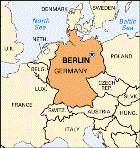Berlin's Humboldt Forum awaits final form
 Berlin - A long-awaited decision on whether or not to reprise the former Hohenzollern royal palace on Berlin's Schlossplatz as the site of the new Humboldt Forum is expected to be made on Friday, November 28.
Berlin - A long-awaited decision on whether or not to reprise the former Hohenzollern royal palace on Berlin's Schlossplatz as the site of the new Humboldt Forum is expected to be made on Friday, November 28.
The royal palace was blown up in the post-World War II years by the communists.
Now the question is whether it should be rebuilt along the same lines as the original, or be followed by a more modern piece of architecture.
Critics have long claimed that a "new palace" building would be unacceptably expensive for no definite economic benefit, and that it would be impossible to reconstruct accurately the interior of the building, since neither detailed plans nor the necessary craft skills are available.
But in 2007, the Bundestag (German Parliament) decided to go ahead with reconstruction plans. According to these, three replica "facades" of the palace would be built, but the interior of the premises would be "modern."
Hefty debate swelled around the "palace project", especially in the years following the fall of the Berlin Wall and the city's joyful reunion.
But now, with a binding decision by a "jury" of city architects and politicians expected shortly, considerable interest centres on which of the competing teams of international architects and planners will win the task of designing the lucrative Humboldt Forum project on the Schlossplatz.
In recent months, opponents of the project have renewed their objections to the "palace project," claiming a reconstruction would be a "pastiche of former architectural styles and an unwelcome symbol of Germany's imperial past."
Work on the Humboldtforum - as the new project is to be called - is expected to begin in 2010, with completion by 2013-14.
The forum is envisaged as an international forum of art, culture and science, "designed to inspire a fruitful dialogue among the cultures of the world," according to the institution's website.
A fervent supporter of the palace project is Wilhelm von Boddien, who has been championing its cause for years now. A Hamburg-based businessman, he had an "imitation" palace facade erected on the Schloss Platz, close to the city's protestant cathedral, in the mid-1990s.
Thousands flocked to see it. Von Boddien's enthusiasm for the case led to millions of euros being raised for the "palace project." A recent survey has shown that 58 per cent of Berliners favour the palace being rebuilt.
That was not always the case, with objections mainly found in the former communist east of the city.
Nevertheless, some city experts have long called for a complete reconstruction of the royal palace. Others say they would be satisfied with a replica of its exterior facades, with modern buildings going up behind them.
German royalty came to an ignominious end at the finish of World War I when Kaiser Wilhelm II abdicated and left for hasty exile in Holland.
The Kaiser had been both German Emperor and King of Prussia.
In November 1918, the Spactacist leader, Karl Liebknecht, declared the "German Socialist Republic" from a balcony of the Stadtschloss, thus ending more than 400 years of royal occupation of the building.
In the Weimar Republic years, parts of the Stadtschloss were turned into a museum while other parts continued to be used for receptions and other state functions.
During the 1939-45 War, the 350 year-old Hohenzollern Palace was struck by allied bombs on the 3rd and 24th of February 1945, reducing it to a blackened shell, although it was still structurally sound.
But the area where it was located then fell within the Soviet Union's zone of occupation, and later in communist East Germany.
Parts of the palace were repaired and used by the communist authorities for several more years, before the East German government decided to blow it up in 1950 - it being regarded as a "symbol of Prussian militarism." (dpa)